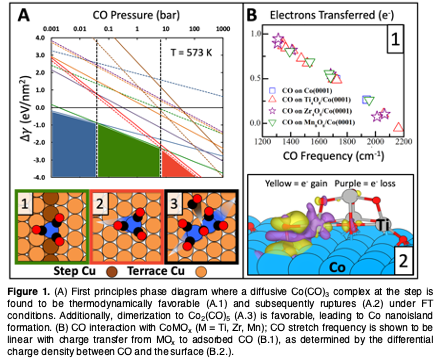Modifying cobalt is a popular means of creating catalysts for the Fischer-Tropsch (FT) synthesis of long-chain oxygenates. Recently, heterogeneous CoCu/metal-oxide-based catalysts were shown to produce these compounds with high regioselectivity. CoCu is known to form a Co@Cu core-shell structure, but we have also shown that CO induces antisegregation. However, the detailed mechanisms of CO activation and dissociation, especially in the presence of metal-oxide interfaces, are still missing. We demonstrate here how CO induces Co and CoCu nanoparticle reconstruction via Co-subcarbonyl formation, Co(CO)
x, which
ruptures from step sites to undergo
dimerization. The influence of metal-oxide interfaces on the adsorption strength of CO and its dissociation are likewise inspected. Quite different from Cu-based metals, oxides likely provide a promotional effect on CO dissociation.
As seen in Figure 1A, a phase diagram (Figure 1A, graph) comparing a large number of possible CO/CoCu structures using the Cu/Co(755) surface, geminal Co tricarbonyl (Figure 1A.1) formation is predicted at ambient pressures while ruptured, diffusive Co(CO)3formation (Figure 1A.2) is predicted to occur above ~7.3 bar and FT-relevant pressures. Exergonic dimerization (~ -0.1 eV/dimer) to Co2(CO)5 (Figure 1A.3) was also shown and suggests a mechanism for Co nanoisland formation. We have subsequently shown this to occur on the vicinal-kinked Co(14 11 10) surface as well, suggesting that this reconstruction mechanism is relevant to FT in general.
With an eye specifically turned toward CO dissociation, we additionally examined the interaction between CO and metal-oxide-doped Co catalysts using small MOx nanoparticles (M = Ti, Zr, Mn) adsorbed on the Co(0001) facet. A linear trend was found between the amount of charge transfer from MOx to CO and the CO stretch frequency (Figure 1B.1). This is visualized via the differential charge density in Figure 1B.2. Overall these phenomena provide a framework for future studies on oxygenate-driven FT.


